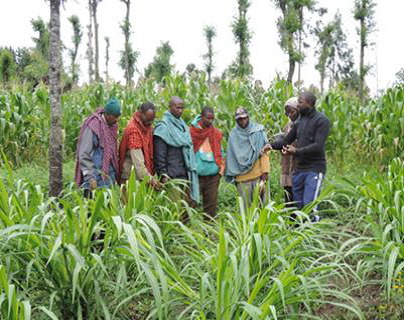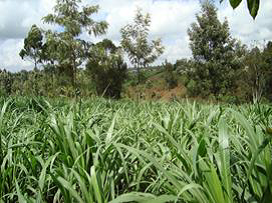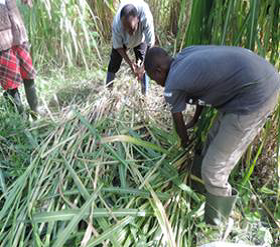Africa RISING making a FEAST for cattle in Babati District, Northern Tanzania

characteristics of Napier grass accessions
Originally published in Forages for the Future Newsletter, issue 3, December 2016
Livestock in Tanzania are largely underfed with farmers meeting only 65% of feed needs in a year, under best conditions. Farm areas with crops range from 0.3 to 0.7 ha, while the area committed to forages is <0.04 ha. Grazing areas are overgrazed and dominated by poor natural pasture species; and high-yielding planted forages lack, especially herbaceous legumes.
These problems are exacerbated by strong seasonal feed variations, high wastage of forage on farms during feeding, and knowledge gaps among farmers on how to select, plant, grow and use planted forages.
The Africa RISING program is working to introduce high-yielding improved forages into existing systems to reduce feed scarcity, nutrient losses and water pollution. A rapid assessment of the farming systems was conducted using the Feed Assessment Tool and the Farmer Centered Diagnosis (FCD) methodology.
This Integrated Livestock Feed Intervention Package, led by ILRI in collaboration with CIAT, consists of three sets of trials including: (a) assessing productivity of Napier grass (Pennisetum purpereum), herbaceous legumes and different combinations; (b) assessing productivity of cereal crop and forage combinations including the integration of fodder trees and shrubs on boundaries and soil conservation structures (contours); and (c) testing performance of forage-based diets. Within the Napier grass trials, soil moisture was measured weekly over a 2-year period.
The aim of the integrated package was to evaluate: (i) suitability and productivity of forages in different agro-climates and farming systems; (ii) the effect of forages on milk yield and; (iii) impacts of forages on water and nutrient fluxes through leaching and runoff to water ways.

Giving farmers a choice of forage options
In every agro-ecological zone, at least one Napier grass accession was outstanding regarding dry matter yield (DM) or quality attributes, giving farmers options to choose from. In participatory assessment, in some cases farmers preferred certain accessions because of their leafiness, ability to endure drought and rapid regeneration after cutting even if they did not have the highest DM yield, indicating that farmers’ preferences need to be accommodated. Different combinations of Napier grass accessions with four legumes (Desmodium intortum cv. Greenleaf, Vigna unguiculata, Vicia villosa and Lablab purpureus) were tested. To encourage faster adoption, two farmer-managed centres for multiplying vegetative planting materials have been established in Long, Sabilo, Seloto and Haillu villages of Babati district.

Planted forages benefit the environment
Water runoff results indicated there were significant differences between the forage grass-legume combinations and the bare control. The control had higher runoff regimes (>60%) than the grass-legume combinations and the forage grasses and forage grass-legume interactions had a significant influence on water productivity.
Clearly graphical trends depicted that some Napier grass accessions were superior, both with Greenleaf and as sole components, over the two years. Overall, the Napier-Greenleaf combination performed better than the Napier-Lablab combination which, in turn, outperformed the sole forage grasses.
Credits:
All photos from Ben Lukuyu, ILRI
By Ben Lukuyu, with contributions from Chris Jones (ILRI)
Further reading:
Kizito, F., Lukuyu, B., Sikumba, G., Kihara, J., Bekunda, M., et al. 2016. The role of forages in sustainable intensification of crop-livestock agro-ecosystems in the face of climate change: The case for landscapes in
Babati, northern Tanzania. In: Climate Change and Multi-Dimensional Sustainability in African Agriculture (pp. 411-430). Springer International Publishing. http://hdl.handle.net/10568/78414
Originally published in Forages for the Future Newsletter, issue 3, December 2016




